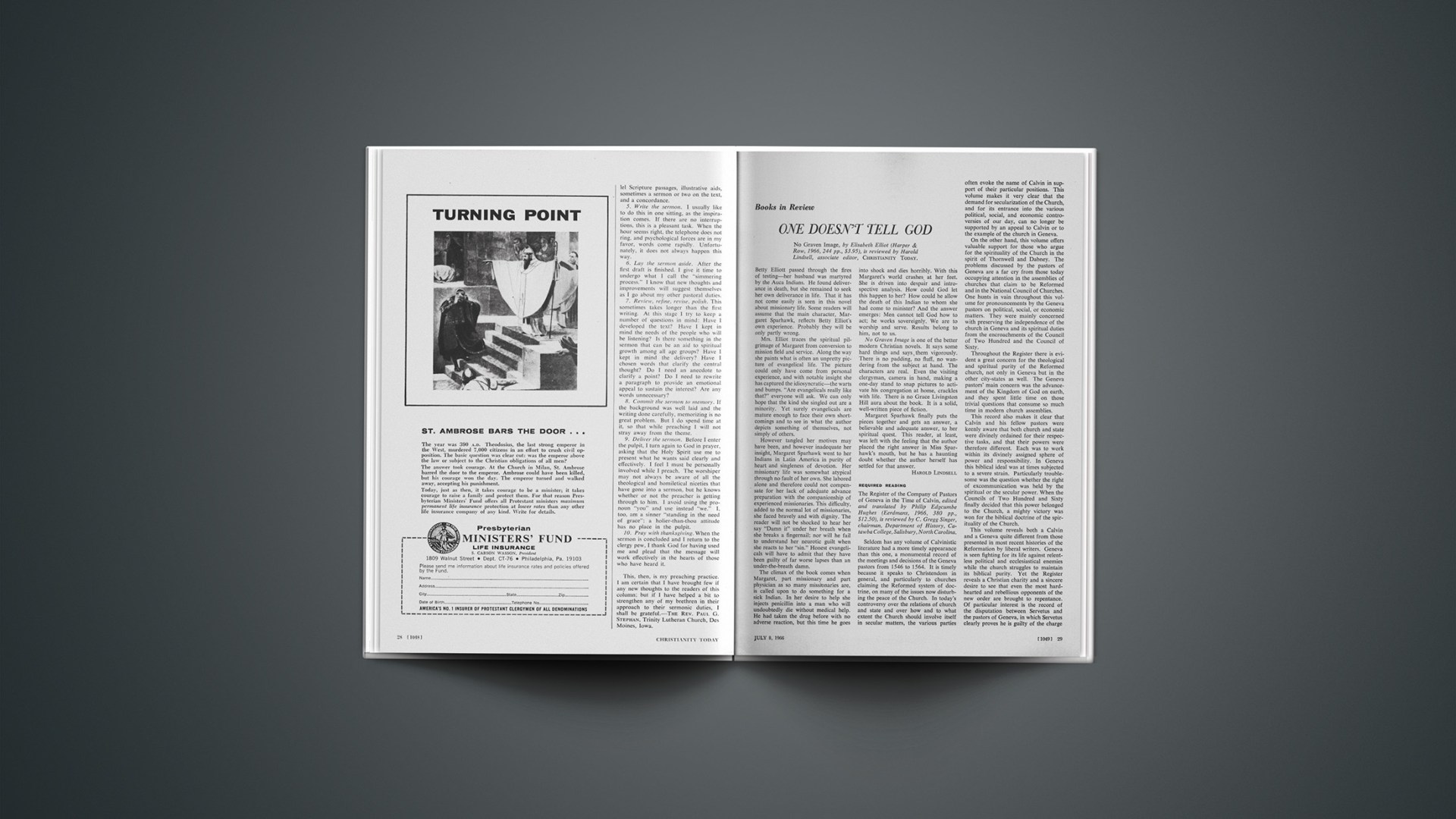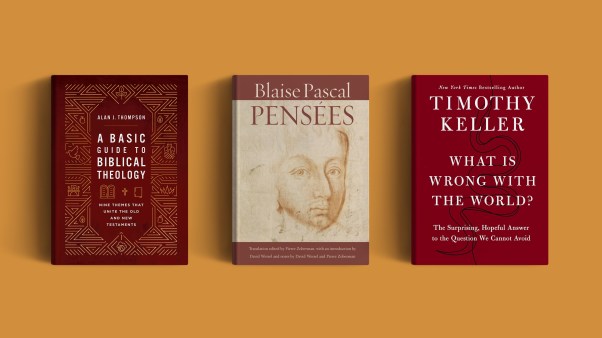One Doesn’T Tell God
No Graven Image, by Elisabeth Elliot (Harper & Row, 1966, 244 pp., $3.95), is reviewed by Harold Lindsell, associate editor,CHRISTIANITY TODAY.
Betty Elliott passed through the fires of testing—her husband was martyred by the Auca Indians. He found deliverance in death, but she remained to seek her own deliverance in life. That it has not come easily is seen in this novel about missionary life. Some readers will assume that the main character, Margaret Sparhawk, reflects Betty Elliot’s own experience. Probably they will be only partly wrong.
Mrs. Elliot traces the spiritual pilgrimage of Margaret from conversion to mission field and service. Along the way she paints what is often an unpretty picture of evangelical life. The picture could only have come from personal experience, and with notable insight she has captured the idiosyncratic—the warts and bumps. “Are evangelicals really like that?” everyone will ask. We can only hope that the kind she singled out are a minority. Yet surely evangelicals are mature enough to face their own shortcomings and to see in what the author depicts something of themselves, not simply of others.
However tangled her motives may have been, and however inadequate her insight, Margaret Sparhawk went to her Indians in Latin America in purity of heart and singleness of devotion. Her missionary life was somewhat atypical through no fault of her own. She labored alone and therefore could not compensate for her lack of adequate advance preparation with the companionship of experienced missionaries. This difficulty, added to the normal lot of missionaries, she faced bravely and with dignity. The reader will not be shocked to hear her say “Damn it” under her breath when she breaks a fingernail; nor will he fail to understand her neurotic guilt when she reacts to her “sin.” Honest evangelicals will have to admit that they have been guilty of far worse lapses than an under-the-breath damn.
The climax of the book comes when Margaret, part missionary and part physician as so many missionaries are, is called upon to do something for a sick Indian. In her desire to help she injects penicillin into a man who will undoubtedly die without medical help. He had taken the drug before with no adverse reaction, but this time he goes into shock and dies horribly. With this Margaret’s world crashes at her feet. She is driven into despair and introspective analysis. How could God let this happen to her? How could he allow the death of this Indian to whom she had come to minister? And the answer emerges: Men cannot tell God how to act; he works sovereignly. We are to worship and serve. Results belong to him, not to us.
No Graven Image is one of the better modern Christian novels. It says some hard things and says them vigorously. There is no padding, no fluff, no wandering from the subject at hand. The characters are real. Even the visiting clergyman, camera in hand, making a one-day stand to snap pictures to activate his congregation at home, crackles with life. There is no Grace Livingston Hill aura about the book. It is a solid, well-written piece of fiction.
Margaret Sparhawk finally puts the pieces together and gets an answer, a believable and adequate answer, to her spiritual quest. This reader, at least, was left with the feeling that the author placed the right answer in Miss Sparhawk’s mouth, but he has a haunting doubt whether the author herself has settled for that answer.
HAROLD LINDSELL
Required Reading
The Register of the Company of Pastors of Geneva in the Time of Calvin, edited and translated by Philip Edgcumbe Hughes (Eerdmans, 1966, 380 pp., $12.50), is reviewed by C. Gregg Singer, chairman, Department of History, Catawba College, Salisbury, North Carolina.
Seldom has any volume of Calvinistic literature had a more timely appearance than this one, a monumental record of the meetings and decisions of the Geneva pastors from 1546 to 1564. It is timely because it speaks to Christendom in general, and particularly to churches claiming the Reformed system of doctrine, on many of the issues now disturbing the peace of the Church. In today’s controversy over the relations of church and state and over how and to what extent the Church should involve itself in secular matters, the various parties often evoke the name of Calvin in support of their particular positions. This volume makes it very clear that the demand for secularization of the Church, and for its entrance into the various political, social, and economic controversies of our day, can no longer be supported by an appeal to Calvin or to the example of the church in Geneva.
On the other hand, this volume offers valuable support for those who argue for the spirituality of the Church in the spirit of Thornwell and Dabney. The problems discussed by the pastors of Geneva are a far cry from those today occupying attention in the assemblies of churches that claim to be Reformed and in the National Council of Churches. One hunts in vain throughout this volume for pronouncements by the Geneva pastors on political, social, or economic matters. They were mainly concerned with preserving the independence of the church in Geneva and its spiritual duties from the encroachments of the Council of Two Hundred and the Council of Sixty.
Throughout the Register there is evident a great concern for the theological and spiritual purity of the Reformed church, not only in Geneva but in the other city-states as well. The Geneva pastors’ main concern was the advancement of the Kingdom of God on earth, and they spent little time on those trivial questions that consume so much time in modern church assemblies.
This record also makes it clear that Calvin and his fellow pastors were keenly aware that both church and state were divinely ordained for their respective tasks, and that their powers were therefore different. Each was to work within its divinely assigned sphere of power and responsibility. In Geneva this biblical ideal was at times subjected to a severe strain. Particularly troublesome was the question whether the right of excommunication was held by the spiritual or the secular power. When the Councils of Two Hundred and Sixty finally decided that this power belonged to the Church, a mighty victory was won for the biblical doctrine of the spirituality of the Church.
This volume reveals both a Calvin and a Geneva quite different from those presented in most recent histories of the Reformation by liberal writers. Geneva is seen fighting for its life against relentless political and ecclesiastical enemies while the church struggles to maintain its biblical purity. Yet the Register reveals a Christian charity and a sincere desire to see that even the most hard-hearted and rebellious opponents of the new order are brought to repentance. Of particular interest is the record of the disputation between Servetus and the pastors of Geneva, in which Servetus clearly proves he is guilty of the charge of heresy and even of apostasy. And it is Servetus who uses coarse and unchristian language, not Calvin and his fellow pastors.
Equally important is the picture of Calvin himself. Rather than the cold, hard-hearted person he is often thought to have been, he appears on these pages as a pastor and teacher dearly loved by those who knew him best and held in high esteem not only in Geneva but throughout Switzerland and in other parts of Europe as well. The tribute his fellow pastors paid him just after his death, when they were faced with the need to choose his successor, is a very moving testimony to him.
This reviewer would recommend that every delegate to church assemblies be asked and even required to read this volume. If this were done, pronouncements issued by the churches and by the National Council of Churches would change radically. As a matter of fact, if the National Council of Churches were to take this volume seriously, it would be led to conclude that it has no right to exist.
C. GREGG SINGER
Successful Text
An Introduction to Christianity, by Robert T. Anderson and Peter B. Fischer (Harper & Row, 1966, 234 pp., $4.95), is reviewed by Addison H. Leitch, professor of philosophy and religion, Tarkio College, Tarkio, Missouri.
Robert T. Anderson is associate professor of religion and Peter B. Fischer professor of humanities and religion at Michigan State University. Each writes some of the chapters of this book, and the introductory chapter is a joint enterprise. Yet the whole work has a unity of purpose and a singleness of style. Since the authors teach in a state university, the book is also characterized by a carefulness in polemics; indeed, if there is a weakness, it lies in the authors’ unwillingness to say very much “for sure” about the Christian faith.
Yet the book does stay within the position the authors express in their preface: “The purpose of this book is to present the doctrines of the major Christian faiths to an audience not necessarily familiar with any of them.… In selection of opinions it tries to avoid what the authors think Christianity ought to be.… Consequently, it is not persuasive in its approach. It avoids offensive comparisons between positions and seeks to be descriptive rather than normative” (pp. ix, x). Within these confines, the book is a success. It is comprehensive, clear, and fair, a product of first-rate scholarship. One gets the impression that both authors are highly committed to the Christian faith and quite unwilling to handle their material casually. Although their treatment will not bring Christian conviction, it does convey information, and the book will be very useful as a textbook.
Despite the authors’ refusal to support a position, a liberal position comes through. It is difficult in a brief review to cite evidence of this. Perhaps the clearest sign lies in the suggested readings at the close of each chapter and the footnotes throughout the text: so far as I know, not a single “conservative” author besides Dorothy Sayers is listed or quoted. This is surely a reflection of where the general teaching of Christianity rests in our public institutions.
ADDISON H. LEITCH
Exciting Orientation
Invitation to the New Testament, by W. D. Davies (Doubleday, 1966, 540 pp., $6.95), is reviewed by Glenn W. Barker, professor of New Testament, Gordon Divinity School, Wenham, Massachusetts.
W. D. Davies, well known in the theological world for his Paul and Rabbinic Judaism and The Setting for the Sermon on the Mount, in this latest work addresses himself to quite a different community and for quite a different purpose. His announced intention is to take the untutored “behind the dust of scholarship to the faith that pulsates in the New Testament” (VII). Although he decries any “attempt at persuasion,” there can be no question that the Edward Robinson Professor of Biblical Theology of Union Theological Seminary is sharing with the reader his own experience with the text. His concern “to present as clearly as possible the essence of the faith of the New Testament” (VII) is meant to challenge the reader to decide whether or not this faith is relevant for twentieth-century man. Such an attempt can only be viewed with respect and admiration.
The book is divided into four parts. Part I provides brief but valuable backgrounds. In addition there are separate chapters that treat the nature of the Gospel (the revelation of the glory of God in the particular events centering around Jesus of Nazareth), its dependence historically upon the early preaching of the Church, and the relationship it sustains to the Old Testament.
Part II introduces the subject matter proper. The witness of the Synoptic Gospels is examined collectively and individually. However, the critical problems, although covered admirably, are treated in such detail that Davies does not have opportunity to develop adequately the meaning of the major events in Jesus’ life.
Part III treats the witness of Paul and reflects Davies at his best. Those who know Paul and Rabbinic Judaism will immediately recognize the conclusions of the earlier work and even the order of presentation. It is of untold advantage, however, to have this material presented briefly and non-technically. Unfortunately, the coverage of Pauline ideas is so detailed that any individual treatment of the epistles is excluded. The result may be that the reader will conclude that Paul was primarily a theologian, and a fairly systematic one at that. The Paul who, as Davies tells us, is first and foremost a missionary wrestling with problems and ideas that daily confront him in the pagan world, does not really ever appear.
Part IV treats the Fourth Gospel. The author’s interpretation follows closely that of his mentor, C. H. Dodd. His contribution here as elsewhere in the book is his remarkable ability to encapsulate complicated and technical positions worked out by scholars and re-present them in terms that an informed student can readily understand.
Although this is an excellent work, several observations should be made. First, the book is scarcely an Invitation to the New Testament. It is rather a kind of exciting orientation in some very important areas of New Testament biblical theology observed over against critical backgrounds. Secondly, whatever the desire of the author, his book is not for novices. Thirdly, the very intent of the book inevitably raises some very important questions. What is the nature of Scripture? What precisely is its authority? Why does its faith deserve this attention? Davies never answers these questions. He does complete his section on the Synoptics by quoting from E. V. Rieu without comment: “Just as Jesus lived in the oral traditions that preceded the Gospels, so he inspired and unified the writings that eventually summed it up. One might almost say that Jesus wrote the Gospels.” It would have been so much more meaningful if Davies had himself made this statement and then proceeded to teach the reader what it means.
GLENN W. BARKER
Effervescent Bishop
The Bishop: A Portrait of the Right Reverend Clinton S. Quin, by Alan Lake Chidsey (Gulf Publishing, 1966, 230 pp., $5.95), is reviewed by Frank W. Blackwelder, rector, All Souls Episcopal Church, Washington, D. C.
The Bishop is the story of a most vigorous, effervescent, and forthright man. Clinton Simon “Mike” Quin, born in 1883, began to work at the age of thirteen, a practice not unusual in those days. When he was almost twenty, however, he began going to night school to study law, and in 1906 he passed the bar examination. Yet his interest in the Episcopal Church was so great that he did not practice law; instead, he entered the Virginia Theological Seminary, graduating in 1909. After serving several churches simultaneously in the vicinity of Louisville, the Rev. Clinton S. Quin became the rector of Grace Church in Paducah, Kentucky, where he continued to use his great energy and insight for the advancement of Christianity through the channel of the Episcopal Church.
Quin cooperated in innumerable community projects but was never carried along by the tide. When Prohibition became a possibility, he held special services for the bartenders of the city to let them know that although the liquor business was being maligned, the Church looked upon the people employed in that business as individuals with souls.
The book shows many examples of the bishop’s quick reaction to valuable innovations of the day. The Boy Scout troop he organized under the auspices of Grace Church now stands as the one with the longest continuous service in the United States. As bishop in Houston, Texas, he immediately saw the value of Alcoholics Anonymous.
Besides being the story of an interesting man, The Bishop is an impressive indicator of how much one person can do when he is completely dedicated to spreading Christ’s Kingdom in the world.
FRANK W. BLACKWELDER
The Idea Is Right
The Satanward View: A Study in Pauline Theology, by James Kallas (Westminster, 1966, 152 pp., $4.50), is reviewed by Andrew J. Bandstra, assistant professor of New Testament, Calvin College, Grand Rapids, Michigan.
Can a worthy cause be harmed more by a poor argument for it than by a good argument against it? This author presents a worthy cause, but it is a question whether his argument will help or hinder.
Dr. Kallas, an ordained Lutheran minister who is associate professor at California Lutheran College, correctly sees the basic importance of demonology and eschatology in the theology of Paul. After an initial chapter on Jesus and Paul, he compares and contrasts “the Satanward view” and “the Godward view” of the work of Christ. The Satanward view develops the work of Christ in terms of conflict with the evil forces, particularly as culminated in Satan. This is contrasted with the Godward view (really an amalgam of Paul, Anselm, Denney, Dodd, Taylor, and Bultmann), which Kallas describes as a transaction within the Godhead between Father and Son in which Christ offers himself as a satisfaction for sinful humanity to God or seeks, by his obedience and example, to return rebellious man back to God.
These two views when carried through in other parts of theology result in divergent, if not contradictory, positions. In the Satanward view, the nature of Jesus is divine, sin is an enslaving power, man is helpless and open to external powers, salvation is objective and cosmic in scope and entered by predestination, and Satan is the ruler of this world and the source of suffering. In the Godward view, the nature of Jesus is human, sin is rebellion and guilt, man is free and self-determining, salvation is subjective and entered by personal decision, and God is the ruler of this world and the source of suffering.
Kallas acknowledges that both views are scriptural and that they must be held in tension. He wishes to show, however, that the Satanward view is primary and determinative (comprising 80 per cent of Paul) while the Godward view is secondary and derivative (comprising 20 per cent). Kallas then develops the Satanward view as it comes to expression in various facets of Paul’s experience and teaching. The final chapter is a sharp and, in many ways, valuable confrontation with Bultmann.
A deeper awareness of “the Satanward view” is a worthy cause, and Kallas has set this forth with vigor. But the argumentation as a whole is a curious mixture of truth, one-sided emphasis, improper dilemmas, and, sometimes, error. In this reviewer’s opinion, Kallas over-emphasizes the contrast between the two views. To be sure, he once states that the views at bottom are not contradictory but complementary (p. 32). But he does not indicate how they might be complementary except at one point (cf. pp. 106 ff.). It appears that Kallas has torn asunder what Paul joined together. For example, he contends that Philippians 2:7 teaches that Christ became the slave of Satan, not a servant of God (p. 78). Although debatable, this may be correct. In the next verse, however, Paul says that Christ became obedient unto death. No doubt Paul means “obedient to God,” but Kallas does not mention the conjoining of these two facets. Does the Satanward view champion the divinity of Christ more than his humanity? If so, it does not adequately reflect Paul. In Philippians 2:5 ff. and Colossians 2:9–15, precisely where Christ’s victory over the evil forces is clearly in focus, the twin motifs of Christ’s divinity and humanity are both prominent; and if either of the two is predominant, it is his humanity (cf. also Heb. 2:14, 15).
In addition, Kallas does not always do careful work; the following are only some of the instances of this. He once quotes Hebrews 2:14 in support of the Satanward view (p. 22) but later (n. 13, pp. 127 ff.) states that the theology of Hebrews dismisses demonology. He implies, no doubt unintentionally, that Paul uses the term “body” as a designation of the Church more than eighty times (p. 92). He uses Galatians 2:20a to support his interpretation that there was a physical tie between Paul and Jesus (p. 95), but he says nothing about Galatians 2:20b. First Corinthians 12:3 does not say that the Holy Spirit makes the confession for us, as Kallas contends (p. 104). It is an improper dilemma to posit that either there is a physical tie between the believer and Christ or faith, as our personal decision, is that which establishes our relationship with him (pp. 100 ff.). Again, Kallas argues that Paul insists that it is not at the moment of faith but at the moment of baptism that a man is joined to Christ (pp., 101 ff.). Later he admits (p. 112) that God also establishes the relationship through the preaching of the Word, although he nowhere indicates that he might have gotten this latter idea from Paul as well (cf. Rom. 10:14).
The cause is a worthy one, especially since, in our day, demonology and eschatology are often either muted or ignored or denied. One hopes that this book, despite its weaknesses, will contribute to a more comprehensive view of the amazing work of Christ. Its author is certainly not devoid of helpful insight into these matters.
ANDREW J. BANDSTRA
Washington Reporters
The Press in Washington, edited by Ray Eldon Hiebert (Dodd, Mead, 1966, 233 pp., $5), is reviewed by Richard Ostling, assistant news editor,CHRISTIANITY TODAY.
Let’s play the analogy game. Start by taking a typical quote from this book:
“The United States Government that runs with the maximum knowledge—in advance—of the people of the country is going to be the best government. I believe that the American people are vitally interested in, for example, the United States disarmament negotiations position and in all other foreign, military, and domestic positions taken by the United States government in their name. Every effort should be made to inform the people—in advance—of what those positions are going to be and to develop through the press a consensus which indicates the feeling of this country and of its people—who are ultimately sovereign in our country.
“Even the difficult-to-understand policies of this country in such technical fields as nuclear energy and disarmament are the business of the people, and it is the job of the reporter to get that information to the people, with or without the co-operation of the bureaucracy.”
This is standard dogma for a journalist (in this case Thomas Schroth, executive editor of Congressional Quarterly). Now read the same excerpt, making appropriate substitutions in order to apply it to the Church and religious issues instead of the government and its policy. A revolution!
In this book, sixteen reporters in the nation’s capital report on how they do their jobs and on what bothers them about the government and the way the press covers it. The strange sound of their comments when applied to religion is one indicator of the journalistic lag in the religious field. Another is that religion rates no mention in this anthology, even though Washington, D. C., is an increasingly important center for religious news.
Books like this, and the superb quarterly Columbia Journalism Review, provide the best available criticism of the press. When Barry Goldwater or Jack Paar tells us reporters are doing a lousy job, he speaks from viscera, not knowledge. But we should listen when Clark Mollenhoff says much of the capital press was “ignorant, gullible, or lop-sidedly partisan,” thus giving comfort to the administration on the TFX and Otto Otepka cases. The Pulitzer Prize-winning correspondent for Cowles Publications also believes the press has so overreacted to the abuses of Senator McCarthy that many veterans “are automatically against any investigations,” even though they provide one of the few ways to force disclosure of information from the Executive Branch. Perhaps the most depressing critique is by James E. Clayton of the Washington Post, who documents sloppy coverage of the U. S. Supreme Court.
Other interesting items: Marvin Kalb of CBS accepts “lying” as “a legitimate part of the defense mechanism of the administration.” He believes covering Washington is harder than covering Moscow because it is difficult for the newsmen not to “succumb to the easy role of being a spokesman for his country.”
Richard Fryklund, who covers the Pentagon for the Washington Evening Star, also expects “outright lying” as part of government “news management.” He has some horror stories about how people who talk to reporters being subjected to lie detector tests or transferred, and about Pentagon reporters who expect to be tailed or to have their phones bugged.
Strangely, the best-known chapter was turned out, not by a “print media” man, but by a broadcaster, Edward P. Morgan of ABC radio. Some of the weakest contributions have too much of the drawl of press-room anecdotes and breathless, blow-by-blow accounts of how a certain beat is covered.
The editor of this volume is chairman of the Department of Journalism at The American University. This fall he takes charge of the new Washington Journalism Center, a graduate-level program for select scholars in the field. CHRISTIANITY TODAY is joining in the venture through semester-long fellowships in religious news, which include internship work on the magazine. If the program succeeds, its products will turn their discerning eyes and steeled talents to religion as these experts have to public affairs.
RICHARD OSTLING
Book Briefs
A flame for God: Biography of Fredrik Franson, by David B. Woodward (Moody, 1966, 190 pp., $3.50). A biography of Fredrik Franson, founder of The Evangelical Alliance Mission and four other foreign mission societies. Like a flaming arrow he flew through the world, kindling the fires of God’s kingdom.
The Rule of Qumran and Its Meaning, by A. R. C. Leaney (Westminster, 1966, 310 pp., $7.50).
New Testament Apocrypha, Volume Two: Writings Relating to the Apostles, Apocalypses, and Related Subjects, edited by Edgar Hennecke and Wilhelm Schneemelcher, English edition edited by Robert McL. Wilson (Westminster, 1966, 852 pp., $10). A technical work of value for the serious student of the New Testament Apocrypha.
Landmarks in Greek Literature, by C. M. Bowra (World, 1966, 284 pp., $8.95). A learned survey of Greek literature. For the serious scholar only.
Still We Can Hope: Assurances That Give Meaning to Life, by Joseph R. Sizoo (Abingdon, 1966, 158 pp., $3). Well-written devotional material with a touch of the poetic.
Plain Talk on Acts, by Manford George Gutzke (Zondervan, 1966, 221 pp., $3.95). This “plain talk” is frequently so puffy that it argues the golden quality of silence. And the interpretations are so often wide of the mark that they suggest the author practices little exegesis, at best, and knows little theology.
The Ghetto of Indifference, by Thomas J. Mullen (Abingdon, 1966, 111 pp., $2.25). “The have-nots lie bleeding along the road, and the haves are passing them by on their way to church.” The ghetto: WASP-land, where dwell the white, Anglo-Saxon (well-fed) Protestants.
Martin Luther, Creative Translator of the Bible, by Heinz Bluhm (Concordia, 1965, 236 pp., $8). A technical study of Luther as Bible translator.
The Life and Times of Jesus: A Contemporary Approach, by Herschel H. Hobbs (Zondervan, 1966, 218 pp., $3.50). A popular, practical study.
What Happened at Rome?: The Council and Its Implications for the Modern World, by Gary MacEoin (Holt, Rinehart and Winston, 1966, 192 pp., $4.95). By a Roman Catholic who combines theological and canon-law training with thirty years of journalistic experience.
The Major Victorian Poets: An Anthology, edited by William H. Marshall (Washington Square, 1966, 786 pp., $7.95). With an introductory essay on the Victorian era.
Fresh Every Morning, by Gerald Kennedy (Harper & Row, 1966, 194 pp., $3.95). Sermonic essays. A good writer provides good reading.
You Can Understand the Bible, by John R. Link (Judson, 1966, 224 pp., $4.75). Essays that turn around what the Bible is, how it was written, and how it should be approached, read, and understood.
Aspects of the Church, by Heinrich Fries (Newman Press, 1966, 174 pp., $4.50). Roman Catholic essays.
The Day God Died, by Lehman Strauss (Zondervan, 1965, 112 pp., $2.50). Essays on the Seven Last Words. The title is somewhat misleading (though it may promote sales), since the author insists that the Son of God died.
Mental First Aid: Toward Balance in a Dizzy World, by Joost A. M. Meerloo (Hawthorn, 1966, 327 pp., $5.95). A vast amount of interesting and valuable information for that time “before the doctor is needed or [and there is some delightful humor here] before he comes.”
Paperbacks
Church Growth in Central and Southern Nigeria, by John B. Grimley and Gordon E. Robinson (Eerdmans, 1966, 386 pp., $3.25). Comprehensive and well documented.
The Wrath of Heaven, by Calvin Robert Schoonhoven (Eerdmans, 1966, 187 pp., $2.45). An interesting study that probes the New Testament material suggesting that both earth and heaven are under the judgment of God until the end of this age, when heaven in the idyllic sense will obtain.
The Prophetic Voice in Modern Fiction, by William R. Mueller (Doubleday, 1966, 186 pp., $.95). First published in 1959.
A Serious Call to a Devout and Holy Life, by William Law (Eerdmans, 1966, 313 pp., $1.95). A classic of Christian devotion.
The Theology of Romantic Love: A Study in the Writings of Charles Williams, by Mary McDermott Shideler (Eerdmans, 1966, 243 pp., $2.45). First paperback edition of a work published in 1962.
New Patterns of Church Growth in Brazil, by William R. Read (Eerdmans, 1965, 240 pp., $2.45). Good overview of why and how churches have grown in Brazil, with emphasis on the strong Pentecostal advance. Fresh lines are laid down to guide Protestant churches in their evangelistic efforts during the next decade.
Anti-Intellectualism in American Life, by Richard Hofstadter (Vintage, 1966, 448 pp., $2.45). First published in 1962.
Planning and Furnishing the Church Library, by Marian S. Johnson, artwork by John Mosand (Augsburg, 1966, 48 pp., $3).
To Mend the Broken: The Christian Response to the Challenge of Human Relations Problems, by Karl E. Lutze (Concordia, 1966, 99 pp., $1.95).
A Christian’s Guide to Church Membership, by David Winter (Moody, 1966, 64 pp., $.95). An intelligent and readable discussion of the meaning, obligations, and glory of church membership.
The Free Church, by James DeForest Murch (Restoration Press, 1966, 140 pp., $1). A good piece of work.
Earliest Civilizations of the Near East, by James Mellaart (McGraw-Hill, 1965, 143 pp., $2.95). A revised edition of chapter 5 of The Dawn of Civilization.
The Road to Peace, by John C. Bennett, et al. (Fortress, 1966, 59 pp., $.85).
Guide to the Debate About God, by David E. Jenkins (Westminster, 1966, 111 pp., $1.45). A very thorough analysis of the possibilities of human knowledge of God in the thought of Bishop Butler, Schleiermacher, Barth, Brunner, Tillich, Bonhoeffer.










